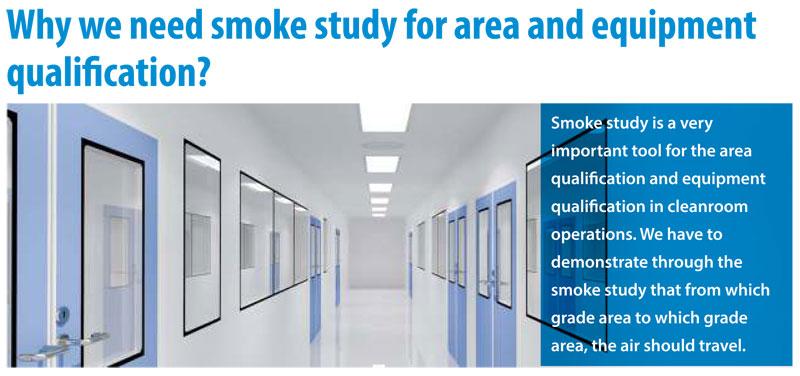
Area Qualification
When we have designed our area for the cleanroom operations, we have to prove that it is maintaining the required area classification. We need to first demonstrate the smoke study for airflow from the terminal HEPA filters which are installed at the ceiling. We have to see that the air is coming down and going to the return riser. And in the return riser we have to demonstrate that airflow is going inside the return riser, and the return riser is actually sucking the air from the area.
To maintain the area classification in cleanroom operations, we have to maintain the air changes. The air changes are maintained by supplying fresh air from the terminal HEPA filter, and that air is taken away by the return riser. This airflow or process flow or the air change cycle goes on and on to ensure that whatever particles are generated in the cleanroom during the operations are getting swept away to maintain the required area cleanliness classification.
Differential pressure between higher and lower grade areas
Next important part in maintaining the area cleanliness is about the differential pressure between the two different classes of area. We have to see that while we open the door, the airflow should be from the cleaner side to the dirtier side of the area.
For example, if it’s Grade B and Grade C, the airflow from the Grade B room should go to the Grade C room. For this, we have to open the door and put the smoke source there and demonstrate that the air from the higher cleanliness area is going to the lower cleanliness grade of the area.
This is another important aspect of the smoke study which demonstrates that airflow when we open the door during our operations is not coming from the lower cleanliness grade area to higher cleanliness grade area.
Third thing is that, in the filling operations there are holes between two areas for the container transfer. From one filling room it goes to, may be to the freeze dryer loading or to the sealing activity. For this, there are holes, usually called as mouse holes. We have to demonstrate that the smoke from that higher grade area is going to lower grade area through that mouse hole.
This is another important aspect of smoke study to demonstrate that area cleanliness or area differential pressure is maintained and from higher cleanliness grade it is going to the lower cleanliness grade area.
Equipment Qualification
When we are qualifying the equipment having the laminar air flow (LAF), the LAF workstation where we perform our various activities, we have to demonstrate that airflow is laminar.
The second part is dynamic pass boxes. Dynamic pass boxes are the pass boxes used for the material transfer from lower cleanliness grade area to higher cleanliness grade area. We have to ensure that this smoke flow is maintained within the dynamic pass box. For that, the use of smoke study is very important.
Third most important equipment is the depyrogenation tunnel. In this tunnel, used for the depyrogenation of the glass containers, we have to demonstrate that there are three different zones – dry zone, hot zone and cooling zone. As per the design of the tunnel, the airflow should be from the filling area to cooling zone, and hot zone should be positive to cooling zone and dry zone.
Various tunnels are slightly different in the design, but whatever the differential pressure criteria defined by the tunnel manufacturer, we have to demonstrate through the smoke study that from which grade area, from which zone to which zone, the air should travel and it has to be demonstrated by the smoke study. That is why putting the smoke study or doing the smoke study for the tunnel is very important.
Fourth important aspect is about the smoke study of isolator. Isolator smoke study is for a different purpose. Apart from the laminarity, it is for the determination of the difficult to reach location for the VHP cycle or the vaporized hydrogen peroxide decontamination cycle.
 About the Author
About the Author
Dhavalkumar Surti has more than 18 years experience in injectable manufacturing, validation, quality assurance and new facility projects. He is with pharmaceutical industry in India from 2003, working with reputed companies like Dr. Reddy’s, Sun Pharmaceuticals, Zydus Pfizer Oncology, Emcure Pharmaceuticals and Aculife Healthcare. He has core experience in aseptic technique, freeze drying, sterilization validation, smoke studies, SOP writing, investigations, training and media fills.
Exclusive







